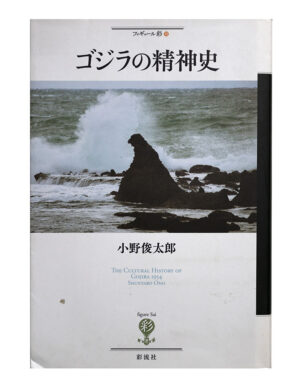10.8.2022
The Cultural History of Godzilla – Pt 15


P 36
ハーヴァード大学の言語学と古典学教授だったカルバート・ワトキンズは『ドラゴンの殺し方』という比較詩学の本のなかで、インド・ヨーロッパ語族において各言語が「英雄が蛇(またはドラゴン)を殺す」という表現をどのように表しているのかをたどっている。この定式のなかで、インドの神話も聖書もギリシャなど各国の神話も同じ発想を根底にもっていることがわかる。そして、ドラゴンと敵対する英雄が最初にはなかった「剣」をもって倒すように変化してきたのだ。
Calvert Watkins, a professor of linguistics and classics at Harvard University, wrote in his comparative poetics book, How to Kill Dragons, that in the Indo-European languages, traces how each language represents the expression “a hero kills a serpent (or dragon).” In this formula, we can see that Indian mythology, the Bible, Greek mythology, and other countries all have the same idea at their roots. And the hero who opposes the dragon has changed to defeat it with a “sword” that did not exist in the beginning.
ユトレヒト半島を中心としたチュートン(ドイツ)系の神話には、「火竜」つまり火焔を吐くドラゴンが登場する。こうしたドラゴンには「ファイヤードレイク」とか「ワイバーン」という名前がついているが、放射能を吐くゴジラの図像的先祖になっている。イギリスの古代英語の叙事詩『ベーオウルフ』の舞台はデンマークだが、火を吐くドラゴンが登場する。こうした古代英文学の研究者でもあったJ・R・R・トールキンも『ホビットの冒険』で火竜を採用した。
In Teutonic (German) mythology centered on the Utrecht peninsula, “fire dragons,”’ that is, dragons that breathe fire, appear. These dragons, with names like “Fire Drake” and “Wyvern,” are the iconic ancestors of the radioactive spewing Godzilla. The British Old English epic, Beowulf, is set in Denmark, but with a fire-breathing dragon. J.R.R. Tolkien, who was also a researcher of ancient English literature, also adopted fire dragons in The Hobbit.
新しい叙事詩映画として
As a new epic movie
『ゴジラ』は英米では「B級SF映画」とか「ホラー映画」とか「惨劇映画」のジャンルに入れられる。ただし、パニックや惨劇や戦いを描くものとして、「叙事詩映画」というジャンルもある。これは主に五〇年代から六〇年代の産物とされるが、五四年の『ゴジラ』はその時期にあたる作品であるし、惨劇も戦いも含まれている。古代や中世の英雄叙事詩や英雄ファンタジーの流れにもつながるスペクタクル映画である。
“Godzilla” is put in the genre of “B grade sci-fi movie”, “horror movie” or “tragedy movie” in the United Kingdom and the United States. However, there is also a genre called “epic film” that depicts panic, tragedy, and battle. This is mainly considered to be a product of the 1950s and 1960s, but 1954’s “Godzilla” is a work that corresponds to that period, and includes tragedy and battle. It is a spectacle film that is connected to the flow of heroic epics and heroic fantasies of ancient times and the Middle Ages.

P 37
歴史上の惨劇が与える「傷」を見つめ直して昇華する手法のひとつがフィクションだとすると、神話の時代からそれを担ってきたのが叙事詩文学だった。民族や集団にとって、それが勝利だろうが敗北だろうが、歴史的な事件を記憶にとどめるための形式となる。結果として「ゴジラ」が、自然物の脅威(恐竜や台風や火山)と人工物の脅威(水爆や脱酸素兵器)が交差する地点を描く叙事詩になったのではないだろうか。
If fiction is one of the methods of reexamining and sublimating the “wounds” of historical tragedies, epic literature has played a role in this since the age of mythology. For nations and groups, whether it is victory or defeat, it becomes a form of remembrance of historical events. As a result, “Godzilla” may have become an epic depicting the point where the threat of natural things (dinosaurs, typhoons, volcanoes) and the threat of man-made things (hydrogen bombs and deoxygenation weapons) intersect.
「ゴジラ」という映画は怪獣ゴジラを倒すという話の軸に、複数の人生や価値観を取りこんでいるので、観客によって解釈が変化する余地がある。小さなエピソードを組みこむことで民族叙事詩ともいえる広がりをもつのだ。 ゴジラが銀座の松坂屋デパートを襲う時に、母親が三人の子供と寄り添いながら、「もうすぐお父ちゃまのところに行くのよ」となだめる。おそらく戦争で父親を失った一家なのだろう。また、血を流して亡くなっている母親のそばで泣き叫ぶ子供を恵美子が抱きかかえるという場面が出てくる。そうした戦いのなかでのエピソードの組み合わせによって、作品世界が立体的に見えてくるのだ。
The movie “Godzilla” focuses on the story of defeating the monster Godzilla, and incorporates multiple lives and values, so there is room for the interpretation to change depending on the audience. By incorporating small episodes, it has a spread that can be called a national epic. As Godzilla attacks the Matsuzakaya department store in Ginza, a mother cuddles up with her three children and soothes them by saying, “We’re going to visit your father soon.” The family probably lost their father in the war. There is also a scene in which Emiko holds a crying child beside her dying, bleeding mother. The combination of episodes in such battles makes the world of the work appear three-dimensional.
闘争を中心とする「叙事詩」は、ヨーロッパの中世には、恋愛を中心とする「ロマンス」と呼ばれ派生形を生み出してきた。この映画では、世界を救う英雄とロマンスの主人公とが分裂している。予告編に「争う恋と理性」とあるように、ロマンスの主人公は南海汽船の子会社でサルベージ作業をおこなう潜水夫の尾形である。だが、ゴジラを倒す英雄となるのは芹沢博士である。その三角関係に巻きこまれるのが山根博士の娘の恵美子だった。彼女を守るというのは二人に共通するのだが、英雄のほうは自分の命を賭ける必要がある。
In medieval times in Europe, ‘epics’ centered on struggle were called ‘romances’ centered on love, and a derivative form was created. The film divides the hero who saves the world from the protagonist of the romance. As the trailer says, “Warring love and reason,” the protagonist of the romance is Ogata, a diver who works as a salvage worker at a subsidiary of Nankai Kisen. However, it is Dr. Serizawa who becomes the hero who defeats Godzilla. Emiko, the daughter of Dr. Yamane, is involved in the love triangle. Protecting her is common to both of them, but her hero has to risk his life.